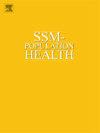Experiences of discrimination across the life course among pregnancy planners in the United States and Canada
IF 3.1
2区 医学
Q1 PUBLIC, ENVIRONMENTAL & OCCUPATIONAL HEALTH
引用次数: 0
Abstract
Little is known about discrimination among pregnancy planners. We used questionnaire data from Pregnancy Study Online (PRESTO), a preconception cohort study, to characterize experiences, attributions, and responses to discrimination (n = 10,460). Eligible participants were assigned female at birth, aged 21–45 years, U.S. or Canadian residents, and not using contraception or fertility treatment. Participants completed a supplemental questionnaire (2013–2024) that included the Philadelphia Urban ACE Survey, Williams' Everyday Discrimination and Major Experiences of Discrimination scales, and Krieger's instrument on responses to discrimination. Mean age at enrollment was 30.9 years. Overall, 83.8 % of participants identified as non-Hispanic White, and 50.4 % had ≥17 years education. Discrimination across the life course varied: 11 % of participants reported childhood racial discrimination, 80.3 % reported ever experiencing everyday discrimination, and 47.2 % reported ever experiencing lifetime discrimination. The most prevalent types of everyday discrimination included being perceived as not smart (63.4 %) and being treated with disrespect (62.6 %), while job-related discrimination was the most frequently-reported lifetime experience (33.9 %). Most Black participants (non-Hispanic and Hispanic) reported their race or ethnicity as one of the main reasons they were discriminated against (87.7 % and 80 %, respectively), while sex or gender was most commonly-reported by other racial and ethnic groups (range: 75.9–82.4 %). Most participants responded passively to discrimination: keeping it to themselves and accepting it as a fact of life (37.4 %). All participants other than non-Hispanic White reported greater exposure to discrimination across the life course, and attributions for discrimination (e.g., race, gender, education, income level) varied across racial and ethnic groups.
美国和加拿大怀孕计划者在整个生命过程中的歧视经验
人们对计划生育者之间的歧视知之甚少。我们使用怀孕研究在线(PRESTO)的问卷调查数据,这是一项孕前队列研究,来描述经历、归因和对歧视的反应(n = 10,460)。符合条件的参与者被分配为女性,年龄在21-45岁之间,美国或加拿大居民,未使用避孕措施或生育治疗。参与者完成了一份补充问卷(2013-2024),其中包括费城城市ACE调查,威廉姆斯的日常歧视和主要歧视经历量表,以及克里格的歧视反应工具。入组时平均年龄为30.9岁。总体而言,83.8%的参与者为非西班牙裔白人,50.4%的参与者受教育年限≥17年。整个生命过程中的歧视各不相同:11%的参与者报告童年时期的种族歧视,80.3%的人报告每天都遭受歧视,47.2%的人报告一生都受到歧视。最常见的日常歧视类型包括被认为不聪明(63.4%)和受到不尊重(62.6%),而与工作相关的歧视是最常见的终生经历(33.9%)。大多数黑人参与者(非西班牙裔和西班牙裔)报告说,他们的种族或族裔是他们受到歧视的主要原因之一(分别为87.7%和80%),而其他种族和族裔群体最常报告的是性别或性别(范围:75.9 - 82.4%)。大多数参与者对歧视的反应是被动的:把它藏在心里,接受它作为生活的事实(37.4%)。除非西班牙裔白人外,所有参与者在整个生命过程中都更容易受到歧视,歧视的原因(如种族、性别、教育程度、收入水平)因种族和民族而异。
本文章由计算机程序翻译,如有差异,请以英文原文为准。
求助全文
约1分钟内获得全文
求助全文
来源期刊

Ssm-Population Health
PUBLIC, ENVIRONMENTAL & OCCUPATIONAL HEALTH-
CiteScore
6.50
自引率
2.10%
发文量
298
审稿时长
101 days
期刊介绍:
SSM - Population Health. The new online only, open access, peer reviewed journal in all areas relating Social Science research to population health. SSM - Population Health shares the same Editors-in Chief and general approach to manuscripts as its sister journal, Social Science & Medicine. The journal takes a broad approach to the field especially welcoming interdisciplinary papers from across the Social Sciences and allied areas. SSM - Population Health offers an alternative outlet for work which might not be considered, or is classed as ''out of scope'' elsewhere, and prioritizes fast peer review and publication to the benefit of authors and readers. The journal welcomes all types of paper from traditional primary research articles, replication studies, short communications, methodological studies, instrument validation, opinion pieces, literature reviews, etc. SSM - Population Health also offers the opportunity to publish special issues or sections to reflect current interest and research in topical or developing areas. The journal fully supports authors wanting to present their research in an innovative fashion though the use of multimedia formats.
 求助内容:
求助内容: 应助结果提醒方式:
应助结果提醒方式:


